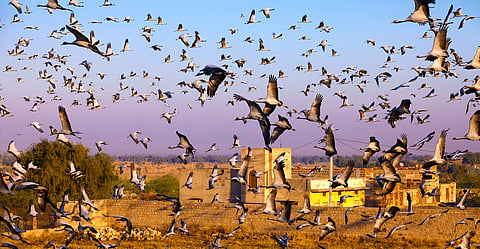SC judgement on ‘orans’ a step forward, with some risks
The legacy of the Godavarman Thirumulpad case continues to shape the governance of India’s forests. It began with the Supreme Court’s landmark 1996 order, which expanded the definition of “forest” to include its “dictionary meaning”, thereby covering diverse forest ecosystems. This jurisprudence has withstood the test of time, reaffirmed most recently in early 2024, when the Court reiterated that “forest” must retain its “broad and all-encompassing” scope when the amended Forest Conservation Act 2023 was under scrutiny.
Over 28 years, the case and its enduring principle have driven more than a thousand interventions, addressing a wide range of issues—from mining and tree felling to protected area management. In 2024, the case entered a new chapter, extending its influence to include Orans—the sacred groves of Rajasthan that are deeply revered by local communities—as ‘forests,’ paving the way for a transformative shift in their protection and governance. It represents a mixed outcome, with some victories to celebrate alongside challenges that require careful consideration moving forward.
Recognising the values of community stewardship
At the outset, the Orans judgment serves as a reminder that forests are far more than dense greenery. They can include diverse ecosystems such as mangroves, wetlands, and scrublands, all vital for biodiversity and livelihoods. Some forests may appear sparse in terms of tree density but still hold immense cultural and ecological significance. The judgment builds on the Central Empowered Committee’s 2005 report, which argued that, in Rajasthan, “large areas are arid areas which support scanty vegetation, grass lands or eco-systems, which have few large trees. Many of these areas represent various forms of climate eco-system such as grass, land, rocky outcrops, stony desert etc. which need to be treated as 'forest land’."
The implications of this judgment extend far beyond Rajasthan, impacting sacred groves dispersed throughout India, from the Jahera of Odisha and Deverakadu in Karnataka to Gujarat’s Devdungar, Sarna in Jharkhand, and Lawkyntang of Meghalaya. The rationale behind the Court’s interpretation reiterates that forests are more than mere collections of trees; they are living entities that are deeply woven into the socio-cultural fabric of communities. The judgment affirms that nature is an organic, inseparable part of community life, embedding spiritual beliefs with ecological stewardship. This perspective echoes the Supreme Court’s 2013 Niyamgiri verdict, which recognised the profound connection between tribal societies and their sacred landscapes.
At the heart of these decisions is the recognition of common property regimes — the rules and practices through which local communities govern and sustain their shared resources. Despite their undeniable cultural and socio-economic significance, commons like Orans have often been overlooked by policy frameworks, typically managed through fragmented or ad hoc mechanisms. In many cases, they are treated as revenue lands, sometimes dismissed as ‘wastelands’. By elevating the care, knowledge, and agency of communities, the Court has shown how traditional wisdom and community stewardship of commons can be integrated into modern legal frameworks.
One of the most significant aspects of the Orans judgment is its emphasis on data-enabled decision-making. The Court’s central directive is to conduct detailed on-ground surveys and satellite mapping of each sacred grove in the state to ensure they are accurately identified, scientifically classified, and formally notified as forests. This evidence-based approach not only formalises their protection but also lays the foundation for effective resource allocation and the creation of a comprehensive registry of common lands in India.
Balancing protection and agency
While the judgment is a step forward, it also raises important concerns. A key issue lies in the disconnect between the principles highlighted by the Court—centred on community care, knowledge, and agency—and the accompanying suggestions. Previously, the proper recognition of Orans within land records already implied their status as lands held for public use, protected from diversion under Section 16 of the Rajasthan Tenancy Act, 1955. The real need is to operationalise this recognition through comprehensive data collection, mapping, and accurate recording across the state—steps that the Court has commendably mandated. This process must ensure that communities’ longstanding custodianship is respected.
However, the Court’s suggestion to integrate Orans into formal legal frameworks, such as declaring them as community reserves under the Wildlife (Protection) Act, 1972 (WLPA) or invoking the Forest Rights Act, 2006 (FRA), presents challenges. Formalisation processes often bring structures that may not account for the adaptive and context-specific stewardship that communities have developed over time. Moreover, they may introduce paternalistic forms of protection or quasi-state mechanisms, potentially sidelining the communities that have nurtured these spaces for generations. For example, requiring communities to now file claims and prove their titles under the FRA, or involving state officials in community reserve management committees under the WLPA, could result in additional layers of oversight that alter the balance of power.
Leaving Orans as ambiguous “deemed forests” without clear guidelines is also not a viable solution. In the months leading up to the judgement, local communities voiced concerns about the potential impact of state intervention on their traditional management systems. It remains unclear whether these concerns were fully addressed by the Court, leaving unresolved questions about the long-term implications for community-led governance of Orans. This paradox highlights the need for a more nuanced approach—one that recognises community governance models while strengthening the ecological agenda. In this light, the Court’s final suggestions for a comprehensive policy to protect the groves offers some hope. Rather than fitting diverse practices into rigid legal categories, such a policy should prioritise participatory, bottom-up governance, with traditional systems of stewardship at its core. By doing so, it can ensure that the future of these sacred landscapes remains firmly in the hands of those who have cared for them over generations.
Pooja Chandran is an environmental lawyer associated with the Foundation for Ecological Security.
Views expressed are the author’s own and don’t necessarily reflect those of Down To Earth or FES.
This column is part of the article "Hold them sacred", first published in the 16-31 January, 2025 print edition of Down To Earth

